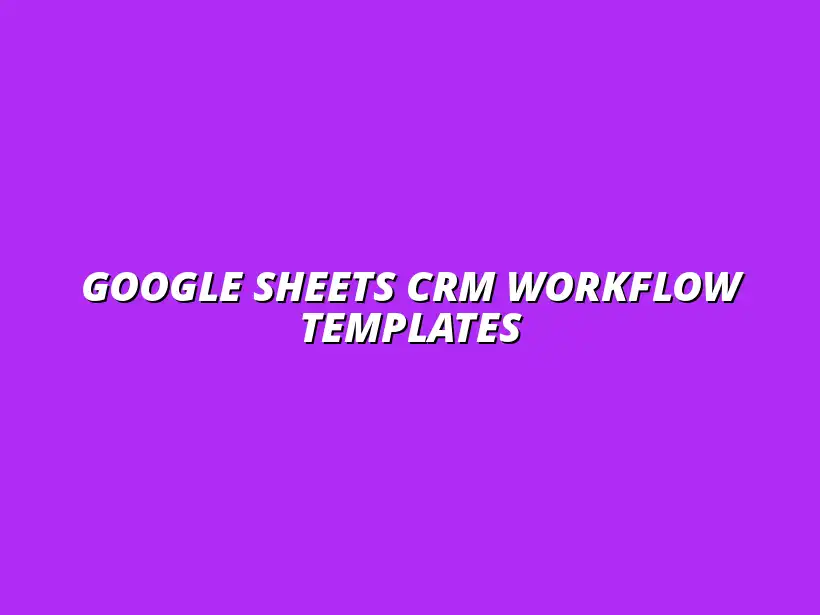
Google Sheets CRM Workflow Templates
Understanding Customer Relationship Management and Its Importance
Customer Relationship Management, often known as CRM, is a crucial aspect of modern business strategies. It involves managing a company’s interactions with current and potential customers, focusing on improving relationships and streamlining processes. Through effective CRM practices, businesses can enhance customer satisfaction and loyalty, which ultimately leads to increased revenue!
CRM systems help in gathering customer data, tracking interactions, and automating various aspects of customer engagement. By leveraging this information, companies can tailor their marketing efforts and address customer needs more efficiently. It is essential for businesses of all sizes to understand and implement CRM strategies to stay competitive in today’s fast-paced market. To streamline your workflow with Google Sheets, consider implementing automation and integration strategies.
Defining Customer Relationship Management (CRM)
So, what exactly does CRM mean? Simply put, it’s a way for businesses to manage their relationships with customers. This includes processes for acquiring, retaining, and ultimately growing a customer base through personalized interactions.
CRM allows companies to collect valuable information about their customers, such as purchase history, preferences, and feedback. With these insights, businesses can create targeted marketing campaigns and improve their product offerings, leading to a better overall customer experience. Effective data management with Google Sheets is crucial for this process.
The Role of CRM in Modern Business
In today's business landscape, CRM plays an indispensable role. It not only helps in organizing customer information but also enables data-driven decision-making. By analyzing customer data, businesses can identify trends and make informed strategies to increase sales.
- Enhances communication with clients.
- Improves customer service responsiveness.
- Offers insights into customer behavior and preferences.
Moreover, CRM tools provide automation features, which reduce manual work and help teams focus on more strategic tasks. This efficiency allows businesses to scale their operations while maintaining strong customer relationships. Learn how to automate Google Sheets with Apps Script to further enhance efficiency.
How CRM Enhances Customer Engagement and Retention
One of the primary goals of CRM is to enhance customer engagement. By utilizing CRM, businesses can send personalized messages, reminders, and follow-ups based on customer preferences. This tailored approach makes customers feel valued and heard!
Additionally, CRM systems track customer interactions, allowing businesses to identify issues before they escalate. By addressing concerns promptly, companies boost customer retention rates and foster long-term loyalty. Ultimately, a strong CRM strategy can transform casual buyers into lifelong customers. For example, a well-designed freelance project management template can greatly improve client communication and project tracking.
Utilizing Google Sheets for Effective CRM Workflows
Google Sheets is a versatile tool that many businesses use for CRM purposes. It allows for easy organization of customer data and can be customized to fit different workflows. Using Google Sheets, teams can create, manage, and share CRM templates that simplify day-to-day operations.
One of the main advantages of using Google Sheets for CRM is its accessibility. Since it’s cloud-based, team members can access and update information from anywhere, making collaboration seamless. This flexibility is especially beneficial for remote teams or businesses with multiple locations!
The Benefits of Using Google Sheets for CRM
When considering tools for CRM, Google Sheets offers numerous benefits. It’s user-friendly and doesn’t require extensive training to get started. Here are some key advantages:
- Cost-Effectiveness: Google Sheets is free for individual users and offers affordable plans for businesses.
- Accessibility: Users can access their sheets from any device with an internet connection.
- Integration: It easily integrates with other Google Workspace tools, enhancing productivity.
By utilizing Google Sheets for CRM, businesses can avoid hefty subscription fees while still managing their customer relationships effectively. It is a practical solution for start-ups and small businesses looking to streamline their workflow. Mastering effective conditional formatting can significantly enhance data visualization and analysis within your Google Sheets CRM.
Cost-Effectiveness and Accessibility
One of the standout features of Google Sheets is its cost-effectiveness. Unlike many dedicated CRM systems that come with high subscription fees, Google Sheets is free for personal use. This saves money, especially for small businesses and startups!
Furthermore, the accessibility of Google Sheets allows teams to work from any location. Whether in the office, at home, or on the go, everyone can access real-time data and updates. This flexibility helps ensure that everyone is on the same page, enhancing overall team collaboration. Efficient workflows with Google Sheets can further boost productivity.
Customization Capabilities for Unique Business Needs
Another strong point of Google Sheets is its customization capabilities. Businesses can tailor their templates to meet specific CRM needs. From tracking leads to managing customer interactions, the flexibility of Google Sheets makes it possible to design a system that fits perfectly!
Users can create formulas, charts, and graphs that visualize data effectively. This level of customization allows businesses to adapt their CRM processes as they evolve, ensuring they remain relevant and effective.
Enhancing Your Google Sheets CRM Templates
To truly unlock the potential of your Google Sheets CRM templates, it’s crucial to enhance them with automation and integration. This not only saves time but also minimizes human error. By implementing these strategies, you can create a more efficient workflow that meets your business needs!
Automation tools can help streamline repetitive tasks, allowing you to focus on building relationships with your customers. Furthermore, integrating Google Sheets with other software can provide a more comprehensive CRM experience. Let’s dive into some effective ways to enhance your templates!
Incorporating Automation and Integration with Other Tools
One of the most powerful features of Google Sheets is its ability to automate tasks using Google Apps Script. This scripting tool can help you perform complex functions like sending emails when certain conditions are met. Imagine the time you’ll save when follow-ups and reminders are automated!
Additionally, integrating Google Sheets with popular CRM software can enhance your data management capabilities. This means you can sync data between platforms, ensuring your team always has access to the latest customer information. Here are a few integrations to consider:
- Zapier for connecting Google Sheets with various apps.
- Mailchimp for email marketing automation.
- Slack for team notifications regarding lead updates.
Using Google Apps Script for Automation
With Google Apps Script, you can create custom functions and automate workflows in your Google Sheets. This might include setting up triggers that run at specific times or in response to certain actions. The flexibility of the script allows you to tailor it to your unique processes.
For example, you can automate the creation of weekly reports, making it easier to track your CRM metrics without manual entry. This is particularly useful for teams that need to stay on top of multiple leads at once!
Integrating Google Sheets with CRM Software
Integrating Google Sheets with existing CRM software can help centralize your data. This way, you can easily access and analyze customer information without switching between platforms. It’s about creating a seamless experience that enhances productivity.
Some popular CRM tools to consider integrating with Google Sheets include:
- Salesforce for comprehensive sales tracking.
- HubSpot for inbound marketing efforts.
- Pipedrive for visual sales pipeline management.
Customizing Templates for Specific Industries
Every business has its unique needs, and customizing your Google Sheets CRM templates is key to addressing those requirements. By tailoring your templates, you can ensure they cater specifically to the challenges and workflows of your industry!
For instance, a small business may require different metrics and layouts than a real estate firm. Understanding these nuances will help you create a more effective CRM solution. Let’s explore some customization ideas for various sectors!
Templates Tailored for Small Businesses
Small businesses often need tools that are simple yet effective. Focus on essential features that can help track leads, customer interactions, and sales progress. A few elements to include in your templates are:
- Contact details of leads and customers.
- Follow-up dates and notes for each interaction.
- Sales stages to visualize where each lead stands.
By keeping your templates uncluttered, you’ll make it easier for team members to navigate and update the information as needed!
Creating Templates for Real Estate, Marketing, and Service Industries
For real estate professionals, templates should emphasize property listings and client preferences. You might want to include:
- Property details and locations.
- Client wish lists for better matching.
- Feedback from property viewings.
Marketers may benefit from templates that focus on campaign tracking and lead generation metrics. Meanwhile, service industry businesses should consider templates that help manage client appointments and service requests. Each industry has unique needs, so make sure to tailor your templates accordingly!
Frequently Asked Questions about Google Sheets Templates for CRM
As you explore Google Sheets templates for CRM, you might have some questions. Understanding how to choose the right template and knowing the limitations of Google Sheets can help make your decision easier. Let’s address a couple of common concerns!
How Do I Choose the Right Template for My Business?
Selecting the right template is all about evaluating your specific business needs. Start by considering what features are essential for your operations. You might want to think about:
- Your team size and structure.
- The types of customer interactions you manage.
- Metrics that matter most for your success.
Once you have a solid grasp of your needs, you can choose a template that aligns best with your goals!
Evaluating Your Business Needs and Requirements
Before settling on a template, assess what works well and what requires improvement in your current CRM process. Engage your team in discussions to gather insights on their struggles and suggestions. This collaborative approach ensures you select a template that benefits everyone!
Seeking Recommendations and Reviews for Templates
Don’t hesitate to look for recommendations and reviews online. You can find valuable insights from other users who have tried specific templates. Consider visiting forums and communities where businesses share their experiences with different Google Sheets CRM solutions.
Can Google Sheets Replace Dedicated CRM Software?
This is a common question, especially for small businesses looking to save costs. While Google Sheets offers a great starting point for CRM, it does have its limitations. Let’s weigh the pros and cons to help you make an informed decision!
Pros and Cons of Using Google Sheets as a CRM Tool
Using Google Sheets has its advantages, such as being free and highly customizable. However, it might lack some features found in dedicated CRM software, like advanced reporting and analytics. Here’s a quick overview:
- Pros: Cost-effective, easy to use, and flexible.
- Cons: Limited scalability, less automation, and potential for data management issues.
Ultimately, whether Google Sheets is right for you depends on your business needs and growth plans.
When to Transition from Google Sheets to Dedicated CRM Systems
As your business grows, you may find that Google Sheets isn’t sufficient for your CRM needs. If you start experiencing issues like data overflow, collaboration challenges, or insufficient reporting, it might be time to explore dedicated CRM solutions. Transitioning at the right time will help you maintain efficiency and support growth!
Practical Tips for Implementing Google Sheets CRM Templates
To maximize the effectiveness of your Google Sheets CRM templates, it’s essential to follow best practices during setup and implementation. By establishing clear processes, you’ll create a smoother experience for your team and improve customer management!
Best Practices for Setting Up Your Google Sheets CRM
First and foremost, establishing data entry protocols is crucial. Clear guidelines on how to input data can help maintain consistency and accuracy. Here are some best practices to consider:
- Define mandatory fields for essential information.
- Use dropdown lists where possible to minimize errors.
- Regularly back up your data to prevent loss.
By doing this, you’ll create a reliable system that everyone can trust!
Regularly Reviewing and Updating Your Templates
Another key practice is to regularly review and update your templates. As your business grows or changes, so should your CRM processes. Schedule periodic check-ins to assess the effectiveness of your templates and make necessary adjustments!
Encouraging Team Adoption and Training
Implementing a new system is only beneficial if your team embraces it. Fostering a culture of adoption will lead to better outcomes and more efficient use of your CRM tools. Start by training your team on how to effectively use Google Sheets templates!
Training Your Team on Effective Use of Google Sheets Templates
Consider hosting training sessions for your team to walk them through the features of your Google Sheets CRM templates. Provide hands-on exercises so they can practice using the templates in real scenarios. This approach will build confidence and enhance overall team performance!
Creating a Support System for Ongoing Questions and Improvements
Finally, create a support system to address ongoing questions and improvements. Having a designated point of contact for troubleshooting and feedback can make a big difference. Encourage team members to share their experiences and suggest enhancements to the templates. This continuous dialogue fosters a culture of growth and improvement!
Final Thoughts on Google Sheets Templates for Streamlined CRM Workflows
In summary, Google Sheets templates can be a powerful tool for managing customer relationships effectively. By enhancing these templates and following best practices, you’ll pave the way for greater organizational success. Remember, the key is to stay adaptable and open to change!
Evaluating the Effectiveness of Your CRM Workflows
As you implement your Google Sheets CRM templates, regularly assess how well your workflows are performing. Establishing key performance indicators (KPIs) will help you measure success and identify areas for improvement. Here’s a list of KPIs to track:
- Lead conversion rates.
- Customer satisfaction scores.
- Response times to customer inquiries.
These metrics will provide valuable insights into how well your system is working!
Key Performance Indicators to Track Success
Regularly reviewing your KPIs can help you identify trends and adjust your strategies accordingly. This proactive approach will keep your CRM processes aligned with your business goals and ensure long-term success!
Continuous Improvement and Adaptation of Your CRM Processes
Finally, always be open to continuous improvement. As your business evolves, so should your CRM processes. By adapting to new challenges and opportunities, you’ll create a more effective and responsive approach to managing customer relationships!




